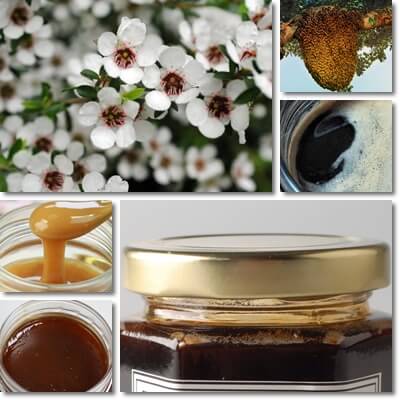Tualang honey and Manuka honey are two specialty honeys with excellent therapeutic potential. Studies show both varieties of honey have significant antibacterial effects as well as anticancer properties owed to both peroxide and non-peroxide agents and a range of antioxidant phenolics. Tualang honey has even been dubbed as ‘the new Manuka honey’.
But what is the difference between Tualang vs Manuka honey in terms of nectar source, uses, appearance, taste, health benefits and side effects?
Tualang honey vs Manuka: type of honey
Both Tualang and Manuka honey are floral honeys, that is, made from the nectar, and incidentally also pollen, collected by honeybees from flowers. The difference is Tualang honey is a polyfloral honey made from nectar from different floral sources. Versus Manuka honey which is a monofloral honey made predominantly from the nectar collected from one floral source: manuka trees, Leptospermum scoparium being the most widespread species of manuka.
However, Manuka honey doesn’t contain just one type of flower nectar because there isn’t such a thing as a honey made 100% from just one species of flowering plant. No, it actually contains nectar from other flowering plants as well, but manuka nectar is predominant.

Tualang honey vs Manuka: source
Tualang honey is a type of wild honey, that is, produced exclusively in the wild from floral sources occurring naturally in the wild. This is why it’s also called Tualang wild honey or Tualang jungle honey. Manuka honey can be produced from nectar from both cultivated manuka trees and manuka trees occurring naturally in the wild.
Tualang honey is an Asian honey by origin because it is produced in the rainforests of south and southeast Asia where tualang trees occur (e.g. Malaysia, Indonesia, Thailand, Philippines). Depending on the country where it comes from, Tualang honey may be called Malaysian Tualang honey, Indonesian tualang honey etc. Manuka honey is from New Zealand and Australia where manuka trees are endemic. But manuka trees can also be found in southeast Asia.
Tualang honey is produced by a species of honeybee native to south and southeast Asia and the Indian subcontinent, called the giant honeybee or the giant Asian honeybee (scientific name: Apis dorsata). Manuka honey is produced by the European honeybee, also called the western honeybee (scientific name: Apis mellifera).

Tualang honey vs Manuka: types
Most agree that there are 3 major types of Tualang honey: yellow, gold or golden Tualang honey, red Tualang honey and black Tualang honey. However, some sources differentiate between all color variations and consider there are up to 5 types of Tualang honey: yellow, gold, red, brown and black Tualang honey. By comparison, there is just on type of Manuka honey.
Tualang honey vs Manuka: appearance
Tualang honey is never one color because there is more than one variety. Yellow Tualang honey and Gold or Golden Tualang honey are usually grouped together under one variety and are a medium, medium-dark yellow-brown or golden-brown color. Red Tualang honey is a dark reddish brown – when it’s settled in the jar, the variety appears almost black, but poured from a honey dipper, it reveals itself a very dark amber color with reddish reflexes. Black tualang honey is a very dark brown to almost black color (it looks like buckwheat honey).
Manuka honey is a medium yellowish brown to caramel color, and is opaque. When it crystallizes, which it does at one point, it turns a lighter color, a paler amber to caramel shade. Exact color may differ slightly depending on where and when the honey is produced and to what extent it is contaminated with other flower nectars. Processing, climate and weather conditions may also lead to slight differences in appearance.
Tualang honey vs Manuka: taste
Tualang honey is a somewhat stronger tasting honey compared to typical honeys such as acacia honey or raspberry honey, with a moderate taste intensity, but exact flavor profile differs across variety and season. Overall, Tualang honey is sweet with light to moderate bitter flavors, depending on the variety, batch, season, floral sources and other factors.
Yellow and Gold Tualang honey has been noted to taste more bitter, but the bitterness is complimented by the natural sweetness of the sugars in the honey. Flavor notes include molasses and sweet black licorice. Tualang honey is on the runnier side, with a slightly higher water content of up to 23% (honey is usually between 13% and 17% water), but nonetheless pleasantly smooth.
Versus Tualang, Manuka honey has quite a unique flavor profile and texture: it’s moderately sweet, dense and creamy, but also slightly grainy, with perceivable sugar crystals that make it taste almost piquant. There is a lingering bitter aftertaste that makes Manuka honey taste almost medicinal, but with rich caramel notes and a faint, almost oily feel. It’s a stronger tasting honey, but extremely pleasant.
Tualang honey vs Manuka: nutrition facts
Neither Tualang, nor Manuka honey is nutritious. The nutritional value of honey is poor, irrespective of variety. At most, the honeys have trace amounts of most essential vitamins and dietary minerals with total content of vitamins and minerals under 1%. Sugar content is around 80% and water content ranges from 13% to 17%, but can go as high as 23% in Tualang honey.
Tualang honey vs Manuka: grading
Manuka honey is graded using several grading systems: MGO, UMF, MGS and KFactor. MGO and UMF in particular are well-established and recognized internationally. MGO (or MG) means Methylglyoxal and measures the content of Methylglyoxal in Manuka honey which is the main compound in the honey responsible for its health benefits. UMF means unique Manuka factor which also refers to the compound Methylglyoxal that is unique to the honey. Find out more about Manuka honey grading systems.
Tualang doesn’t have an internationally recognized grading system yet, but the wheels are spinning. In countries such as Malaysia, there is emphasis on quality and purity, and authorities are striving at ensuring a standardized product of the highest quality.
Find out more about tualang honey.
Tualang honey vs Manuka: health benefits
Tualang and Manuka honey have a comparable therapeutic action and can be used for roughly the same purposes. Uses are therapeutic and cosmetic, both internal and external, and rely on the highly biologically active components in the honeys. The honeys owe their health benefits to both peroxide and non-peroxide antimicrobial components (e.g. gluconic acid and hydrogen peroxide in Tualang honey, methylglyoxal in Manuka honey).
Tualang and Manuka honey have scientifically proven antibacterial benefits with bactericidal, bacteriostatic properties and an antiseptic action. One difference is that, compared with Manuka honey, Tualang honey is more effective against some Gram-negative bacteria strains in burn wounds (source). Both honeys exhibit anti-inflammatory, antioxidant, antiproliferative, antimutagenic, antitumor, and even antidiabetic properties, and have a tissue regeneration and wound-healing action.
Tualang honey vs Manuka: side effects
- Side effects: allergic reactions. It is possible to experience an allergic reaction after eating either Tualang or Manuka honey. The allergic reaction can be a response to pollen in the honeys, or to the honey itself and can build up to anaphylactic shock. People with multiple pollen allergies have increased risks of allergic reactions.
- Contraindications: use in children under 1. Use of raw, unpasteurized honey is to be avoided in children under 1 year of age due to risks of botulism.
- Risks: contamination and adulteration. Both Tualang and Manuka honey are rare varieties of honey, and pricy too. Authorities estimated that around a third of products currently on the market are adulterated, completely fake or contaminated since demand for the honeys does not correlate with supply. This is why it’s important to get your honey from reputable sources and look for adequate certification and transparency with regards to the place and time of harvest.
